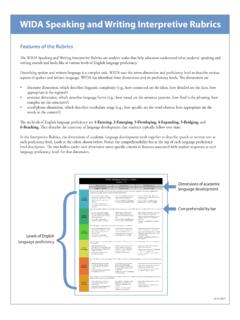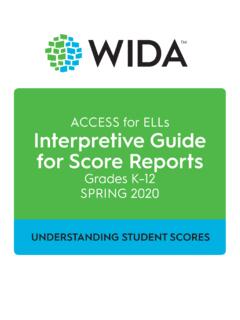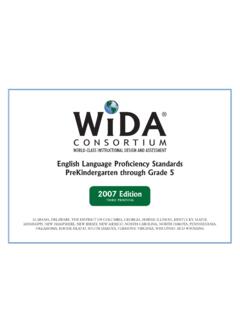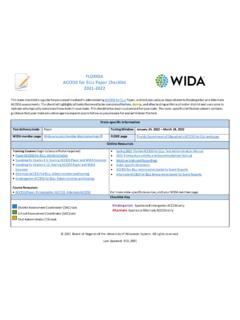Transcription of Can Do Descriptors - University of Wisconsin–Madison
1 Can Do Descriptors KEY USES EDITIONG rades 6-8 The WIDA Can Do Descriptors , Key Uses Edition, Grades K 12 The WIDA Can Do Descriptors provide examples of what language learners can do at various stages of English language development in listening, speaking, reading and writing. The WIDA Can Do Descriptors , Key Uses Edition is one component of the WIDA Standards Framework (shown at right). The framework, as a whole, supports the implementation of the WIDA English Language Development Standards in the instruction and assessment of language learners. We encourage educators to use the WIDA Can Do Descriptors , Key Uses Edition in conjunction with the other components of the framework, along with the previous edition of the Can Do Descriptors .
2 For more information on the WIDA Standards Framework, visit The WIDA Can Do Descriptors , Key Uses Edition provides examples of academic language use for four specific communicative purposes. These purposes, referred to as Key Uses, were identified based on reviews of literature and a language analysis of college and career readiness standards: Recount: To display knowledge or narrate experiences or events. example tasks for the Key Use of Recount include telling or summarizing stories, producing information reports, and sharing past experiences. Explain: To clarify the why or the how of ideas, actions, or phenomena.
3 example tasks for the Key Use of Explain include describing life cycles, sharing why or how things work, stating causes and effects, and sharing results of : To persuade by making claims supported by evidence. example tasks for the Key Use of Argue include stating preferences or opinions and constructing arguments with : To interact with others to build meaning and share knowledge. example tasks for the Key Use of Discuss include participating in small or large group activities and WIDA Can Do Descriptors , Key Uses Edition and the example Descriptors are not exhaustive but are meant to help guide the planning and conversation around meaningful participation of language learners in stardards-based contest curriculum, instruction, and assessment.
4 2 Exemplifying the WIDA Can Do PhilosophyPerformanceDe nitionsStandards & their MatricesGuiding Principles of Language DevelopmentDevelopmentally-Appropriate Academic Languagein Sociocultural ContextsWIDA Standards FrameworkOrganization of the WIDA Can Do Descriptors , Key Uses Edition, Grades K 12 The WIDA Can Do Descriptors , Key Uses Edition is organized by grade-level bands (K, 1, 2 3, 4 5, 6 8, and 9 12) that correspond to those in ACCESS for ELLs Within each grade-level band, the Descriptors are organized by Key Use (Recount, Explain, Argue and Discuss) and within each Key Use, there are example Descriptors for WIDA s six levels of language proficiency (ELP Levels 1 6).
5 The Descriptors in Level 6 represent the language performance of students who have met all the criteria for Level 5. Unlike the Descriptors at Levels 1 5 that provide examples of performance at the end of the level, the Descriptors at Level 6 are examples of performance within Level 6. For three of the Key Uses (Recount, Explain, and Argue) you ll see Descriptors for the four language domains (Listening, Reading, Speaking, and Writing). The Descriptors for the Key Use Discuss are only shown for oral language. The Key Use Discuss highlights the importance of oral language development for meaningful participation of all language learners, regardless of their level of language proficiency.
6 Potential Uses for the WIDA Can Do Descriptors , Key Uses Edition AudiencesThe WIDA Can Do Descriptors , Key Uses Edition can who work with language learners, including coaches, teachers ( , general education, gifted and talented, special education, Title I), language specialists, and support staff. Differentiate curriculum, instruction, and assessments designed in English based on language learners levels of English language proficiency Collaborate and engage in instructional conversations about the academic success of language learners in English environments Advocate for equitable access to content for language learners based on their level of language proficiencyAdministrators and school leaders Communicate with other educators about students English language development Support the WIDA Can Do Philosophy throughout schools and districts Advocate for equitable access to content for language
7 Learners based on their level of language proficiencyStakeholders are encouraged to use the Can Do Descriptors beyond the audiences and purposes identified above to advocate on behalf of language Level 1 EnteringELP Level 2 EmergingELP Level 3 DevelopingELP Level 4 ExpandingELP Level 5 BridgingELP Level 6 ReachingLISTENINGP rocess recounts by Identifying familiar objects or places from oral statements Pointing to objects, people, or places based on short oral descriptions Process recounts by Sequencing labeled visuals per oral directions Identifying settings or time frames in narrative or informational scenarios read aloudProcess recounts by Matching main ideas of familiar text read aloud to visuals Stating the next event in a series based on clues from narrative or informational oral textsProcess recounts by Identifying main ideas and details in oral discourse Evaluating oral presentations of peers based on criteria for successProcess recounts by Categorizing details of
8 Content-related main ideas seen and heard in videos or other technologies Sequencing a series of illustrated events from oral passages ( , historical recaps)Process recounts by Identifying key ideas expressed orally Identifying new information expressed by othersSPEAKINGR ecount by Answering select Wh-questions Naming and briefly describing past community or school events using visual support ( , posters, photographs)Recount by Stating main ideas or points of classroom conversations Restating details of content-related topics (in home language and English)
9 In small groupsRecount by Relating a series of events by expressing time in multiple tenses Connecting ideas in content-related discourse using transitions Recount by Paraphrasing and summarizing content-related ideas presented orally Connecting ideas with supporting details in a variety of oral venuesRecount by Producing oral multimedia, content-related reports based on research from multiple sources Tracing the evolution of literary characters, themes, and plots from different venues ( , digital text or video) Recount by Restating new information expressed by others in extended speech Posing questions that elicit elaboration and responding to others questions and comments KEY USE OF RECOUNTBy the end of each of the given levels of English language proficiency* English language learners *Except for Level 6.
10 For which there is no Level 1 EnteringELP Level 2 EmergingELP Level 3 DevelopingELP Level 4 ExpandingELP Level 5 BridgingELP Level 6 ReachingREADINGP rocess recounts by Identifying responses to Wh- questions in charts or illustrated text Identifying icons in graphs, charts, and environmental print related to familiar topicsProcess recounts by Sequencing illustrated text of narrative or informational events Locating main ideas in a series of simple sentencesProcess recounts by Identifying topic sentences, main ideas, and details in paragraphs Connecting people to actions based on oral descriptions with detailsProcess recounts by Ordering paragraphs in narrative and informational text Identifying summaries of passages in a variety of genresProcess recounts by Sequencing main ideas, events, and conclusions in narrative and informational text Matching details of content-related topics to main ideasProcess recounts by Identifying a central idea of a text and how it is conveyed through particular details.









